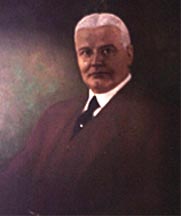The Man Behind The School

William H. Miner
October 22, 1862 – April 3, 1930
William H. Miner Jr. was born in Juneau, Wisconsin, son of Martha (Clapp) Miner and William Henry Miner. His mother died of consumption on Marth 13, 1867. His father died on January 14, 1873, leaving his son an orphan at the age of ten. For six months, young William Henry lived with his only sibling, his married sister in Lafayette, Indiana. In June, he was brought east (his grandfather, Clement Stebbins Miner had settled in Chazy in 1818) and taken into the old farm house of his aunt and uncle, Huldah and John Miner, who were childless. Here he remained until he was 18 years old, attending the one room district school and doing chores on the farm under the strict discipline of his Uncle John, who taught him to be a good farmer.
After his eighteenth birthday, he seriously considered what he was going to do for himself. On December 27, 1880 “Will” set out by coach for Lafayette, where he found a job with the Wabash Railway as a machine shop apprentice. In 1882 he went to Minneapolis to serve an apprenticeship with the Prey Manufacturing Company and remained about four years during which he also went to night business school and studied engineering at the University of Minnesota. He worked for several companies in many different positions between 1886 and 1891. In 1891, he began working as mechanical superintendent for the Hutchins Refrigerator Car Co., a pioneer in the use of refrigerated fruit transportation from California to New York. Many of the refrigerator cars were having draft gear failures resulting in fruit spoilage on route. Challenged by the problem, W.H. Miner worked out a spring draft rigging to overcome the difficulty, on which he was granted U.S. Patent 461,443 on October 20, 1891.
On February 2, 1897 he established W.H. Miner, Inc. in one small room at 255 The Rookery, Chicago, Illinois. As the firm expanded, new products were developed including, in 1904, a friction draft gear for heavier railroad cars and locomotives. His device eliminated much expensive damage to railroad equipment and the millions began to roll in.
Uncle John Miner died in 1893. In 1903, William Henry Miner and his wife Alice Trainer Miner, came to Chazy to make their residence on the 144 acre family farm and began immediately to develop the property into a gigantic model of its kind.
His local philanthropic interests, in addition to the building of Chazy Central Rural School (1916) for $2,000,000 include a 212 room Physicians Hospital in Plattsburgh (1926) for $4,000,000, numerous dams and power houses in and around Chazy, the Kent-Delord House Museum in Plattsburgh and the Colonial Home in Chazy. Ironically, he died from the complications of a tonsillectomy in the Physicians Hospital. When Mr. Miner died in 1930, he was one of the wealthiest men in the United States. His various interests were continued, with the guidance of his widow under the William H. Miner Foundation, established by Mr. Miner in 1923. The foundation functions with seven trustees whose headquarters are in Chicago. A great deal of the land from the no longer functioning Heart’s Delight Farm has been turned over to the William H. Miner Agricultural Institute at Chazy, the 650 acre area around Lake Alice became a game management area in July 1953 under the State of New York, in 1961 the Miner Lake area was deeded to the town of Altona as a public recreation area, and the Chazy Lake Dam property was transferred to the Town of Dannemora. The farm as an institution was dissolved on August 1, 1963.
Reprinted with permission from A History of Chazy by Mrs. Benjamin F. Sullivan and Mr. David Kendall Martin.

